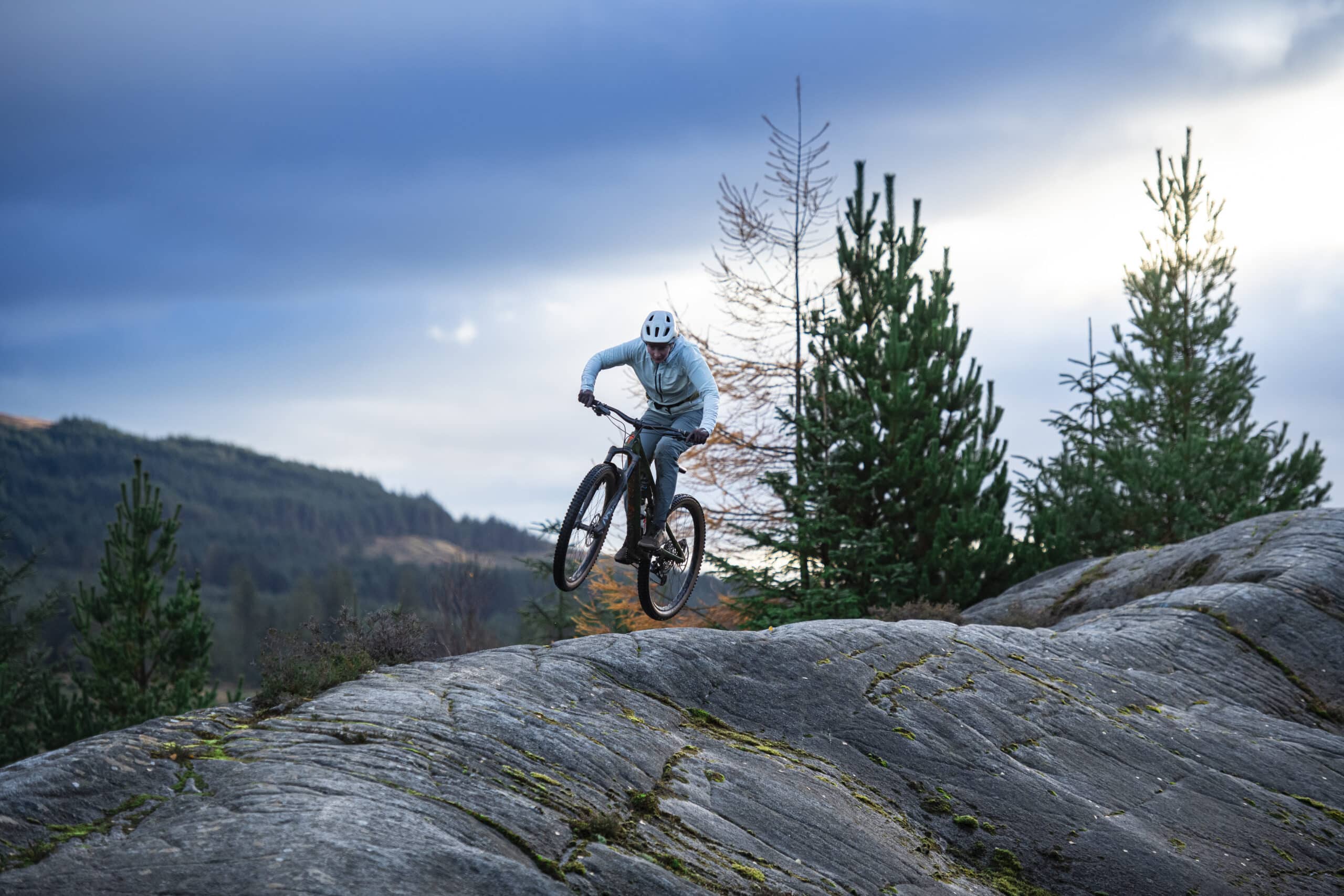It’s not just the Amazon rainforest that’s at risk. Here in the UK, our own temperate rainforests are vanishing too.
Words & Photography Pete Scullion

I know what you’re thinking. Britain… Rainforest… What on earth is this guy on about? Much can be gleaned, however, from the word that precedes ‘rainforest’. When we use that word, almost everyone will think of something akin to the Amazon and Sir David Attenborough creeping through the lush undergrowth that sits beneath some of the world’s tallest trees. That is a tropical rainforest.
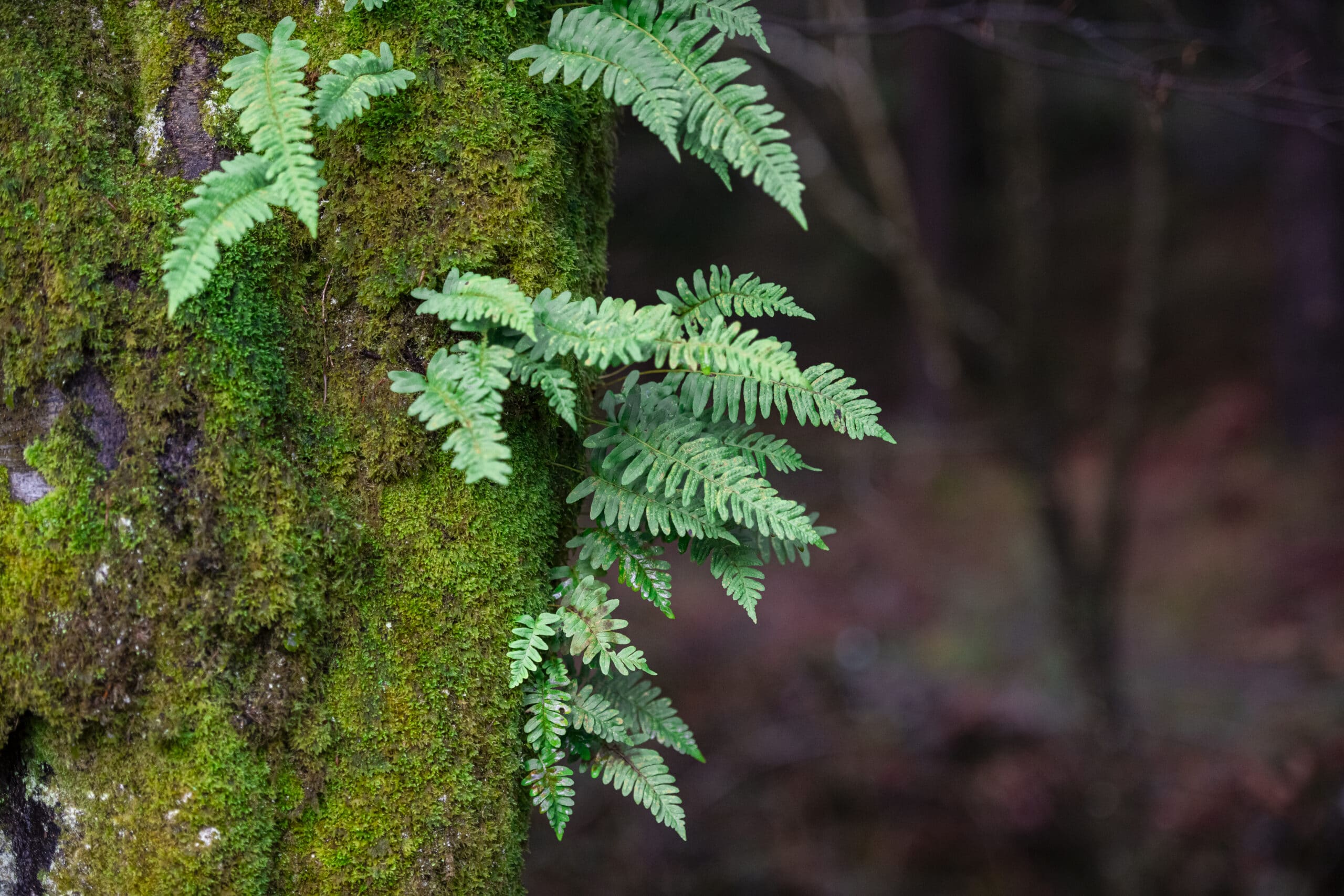
What once carpeted the north and west of the British Isles was temperate rainforest. These rainforests were, and in some places still are, home to ancient woodland made up of mixed native hardwoods that foster a unique mix of lichens, mosses and liverworts that exist almost exclusively in these microclimates. This habitat plays host to other species, from water voles to fungi as well as butterflies and moths.
Latest Singletrack Merch
Buying and wearing our sustainable merch is another great way to support Singletrack
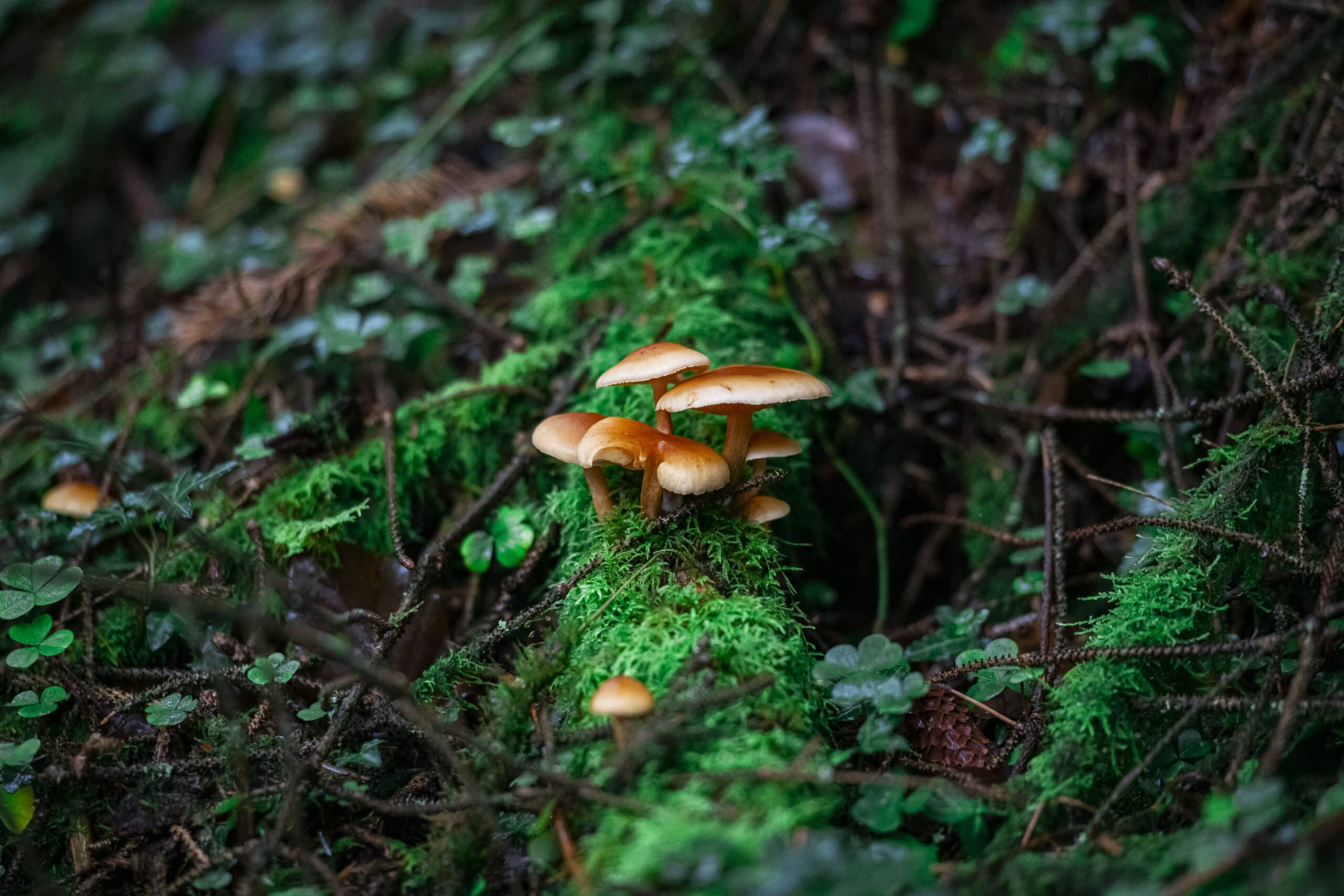
Sadly, much of the UK’s ancient woodland has vanished. Many of the massive hardwood giants were used to fuel the industry that made these shores so powerful, and some 6,000 trees were used to create each warship that patrolled the seas in the early to mid-19th century before the advent of the ironclad warship. Ancient hardwoods take centuries to get to a size where they would be useful for building warships, with oak prized for its strength and the first choice for such ships. When he won his famous victory at the Battle of Trafalgar in 1805, Admiral Horatio Nelson had 27 such vessels at his disposal. They would have taken over 160,000 trees to construct. Then factor in everything else that required timber for construction or fuel – our land would have been decimated. Saplings then would only just be known as ancients today, making replacement a slow process…
Mr Wood? The doctor will see you now
Scotland’s Caledonian Forest is one such temperate rainforest that would once have covered vast swathes of the country. It has been replaced in part by large conifer plantations that typify a lot of the mountain biking experience, as well as open moorland. Some pockets remain in places where they are protected, on ground too poor to plant or just out of sheer luck. These pockets will be the cornerstone of any ancient woodland regeneration going forward. Oak, Scots pine, silver birch, rowan, hazel and beech often grow together in these deciduous woods.
Kirroughtree sits on the southwest extremity of what would have been this vast ancient woodland as well as being on the same flank of the rainforest that once occupied most of Dumfries and Galloway. With that in mind, I’m meeting Manon Carpenter here to see if the ancient woodland marked on the NatureScot maps remains and if it does, what sort of state it’s in. Most will know Manon as a rider who took a World Cup overall and the World Championship Downhill titles in the same year, fewer might know that she’s studying for a PhD in Geology looking at plate tectonics. She’s also a Patagonia ambassador, an advocate for the trails we ride, and has a keen eye for the parts of our environment that can help tackle climate change.

We’ve acquired a checklist that will help us identify pockets of temperate rainforest where they do exist, looking for lichens and bryophytes (spore-producing plants) which include mosses and liverworts. Tree and canopy types, rock substrata and rotting wood all play into what makes the difference between a rainforest and one that isn’t. Spotting these will be key indicators that we’re in a well-established temperate rainforest.
We arrive at Kirroughtree to find the place utterly deserted. Yes, it’s mid-November and yes it’s a Monday morning but we expected to at least see some sign of life, even if the place wasn’t going to be awash with mountain bikers. Despite the Marie Celeste feel, our plan is fairly straightforward: use the existing trail centre routes to hunt out what remains of the ancient woodland and find out where it’s been replaced by plantation.

Not all green is good
Out of the car park and, almost immediately, we’re treated to a short piece of singletrack that seems like a natural green room. The cool darkness is quite the opposite of the brightness of the car park. Moss clings to any surface outside of the gravel, water droplets drip slowly down the greenery. Mushrooms of all kinds push through this green carpet everywhere we look. All is not as it seems though. This is a pine plantation.
These forestry blocks are often carpeted with mosses, owing to the abundance of shade and moisture, so they look far healthier than they actually are. This popular tree crop in the UK doesn’t actually allow enough light to penetrate to the forest floor for anything else to grow. More often than not, you’ll simply see a carpet of pine needles that in turn make it very difficult for anything else to take hold.
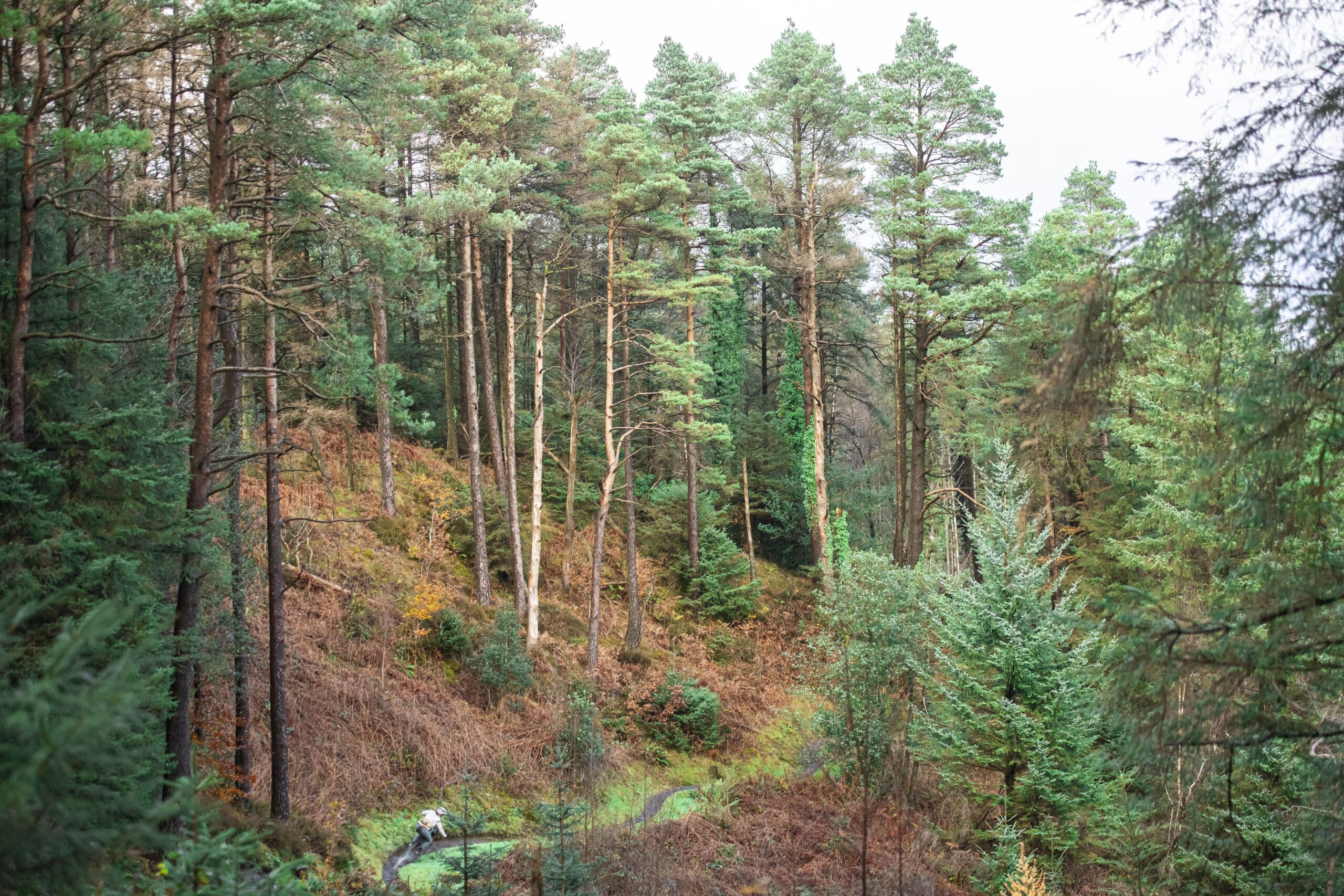
Out of the darkness and into a much more mixed woodland, some tall Scots pines rise above the bracken and bramble-heavy forest floor. Both of these plants can hamper the regeneration of a woodland and often the best trick is to acquire the services of Highland cattle. Not only do these magnificent beasts turn the earth over, but they’re also well known for trampling and eating much of the invasive and non-native species, albeit to the detriment of the blackberry harvest. Manon is quick to spot a small stand of rhododendrons. Pleasing to the eye, but a real menace that’s incredibly difficult to fully root out.
Our next port of call is the western run of the blue. This just happens to be a large looping forest track, but it’s a great way to check out Larg Hill – a hill that the NatureScot map indicates was once ancient forest, which has since been planted with a timber crop. Around the base of the hill, where the blue runs are, is a series of small cliffs, quite unsuitable for planting and as a result, the ancient woodland has held on. It’s here we get our first proper glimpse of what the hill would, and should, have looked like.
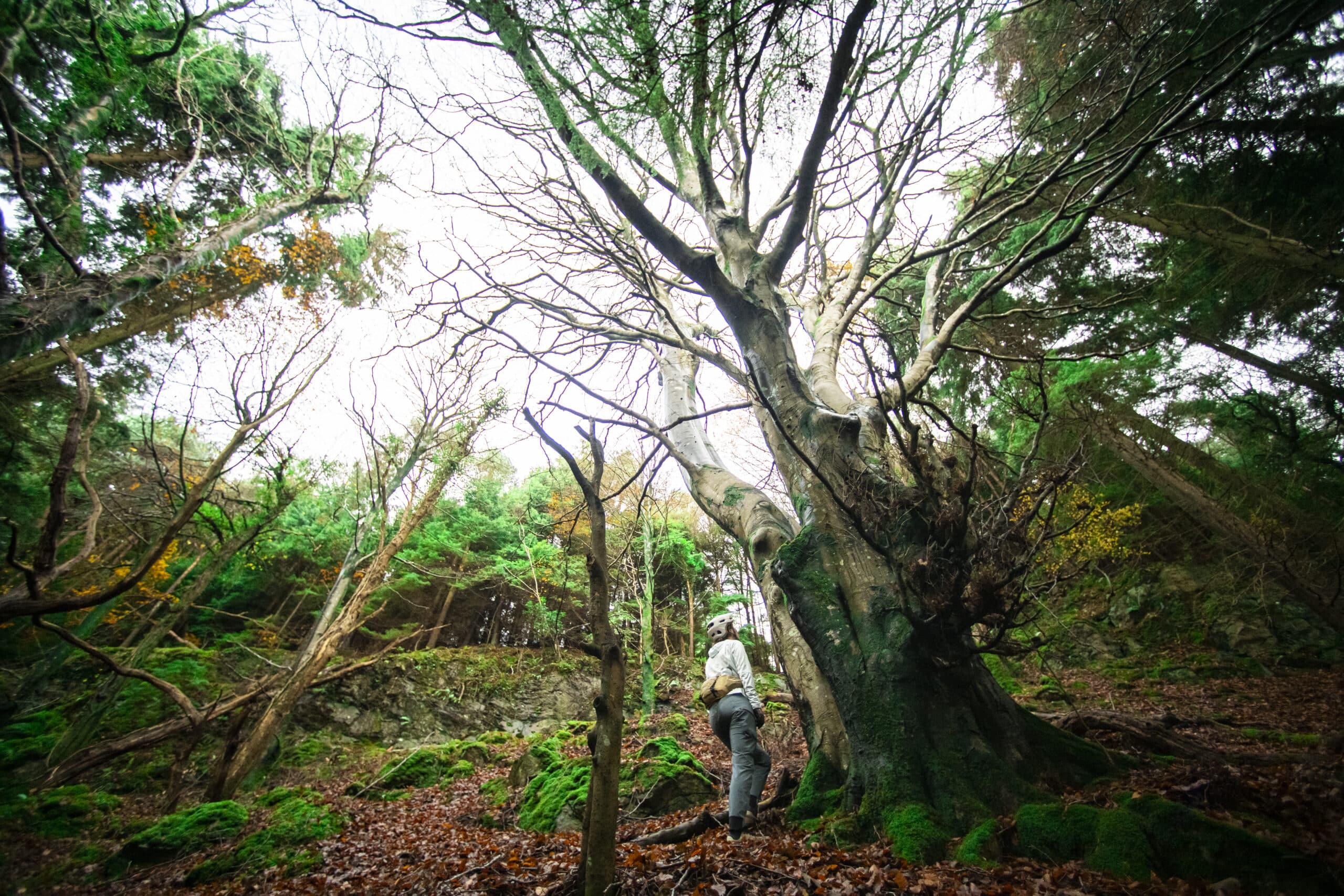
A giant beech tree towers over everything around it. Its bark is weathered from centuries of standing up to the prevailing wind that rolls off the sea less than a mile away and it looks like elephant skin. On its lower trunk, mosses are climbing ever higher. This mighty tree has hanging deadwood complete with various types of fungi, has spawned more of its own number, and sits within a mix of trees that almost covers the full list of what we’re looking for. On top of that, the large canopy allows plenty of light to the forest floor, although with full leaf cover, this might well be a different story. Either way, it’s a far cry from the green room and even more so from what we find just around the corner.
To the west of the track, hemmed in by the farmland beyond, the ancient woodland has remained, thanks to mostly being a bog, but uphill of the track, darkness prevails. Western hemlock is a grand old evergreen that you would more often than not see in the grounds of a stately home but is another Alaskan import that doesn’t offer much in the way of light to the forest floor and lends plenty of acidic needles as a carpet to the gloom.
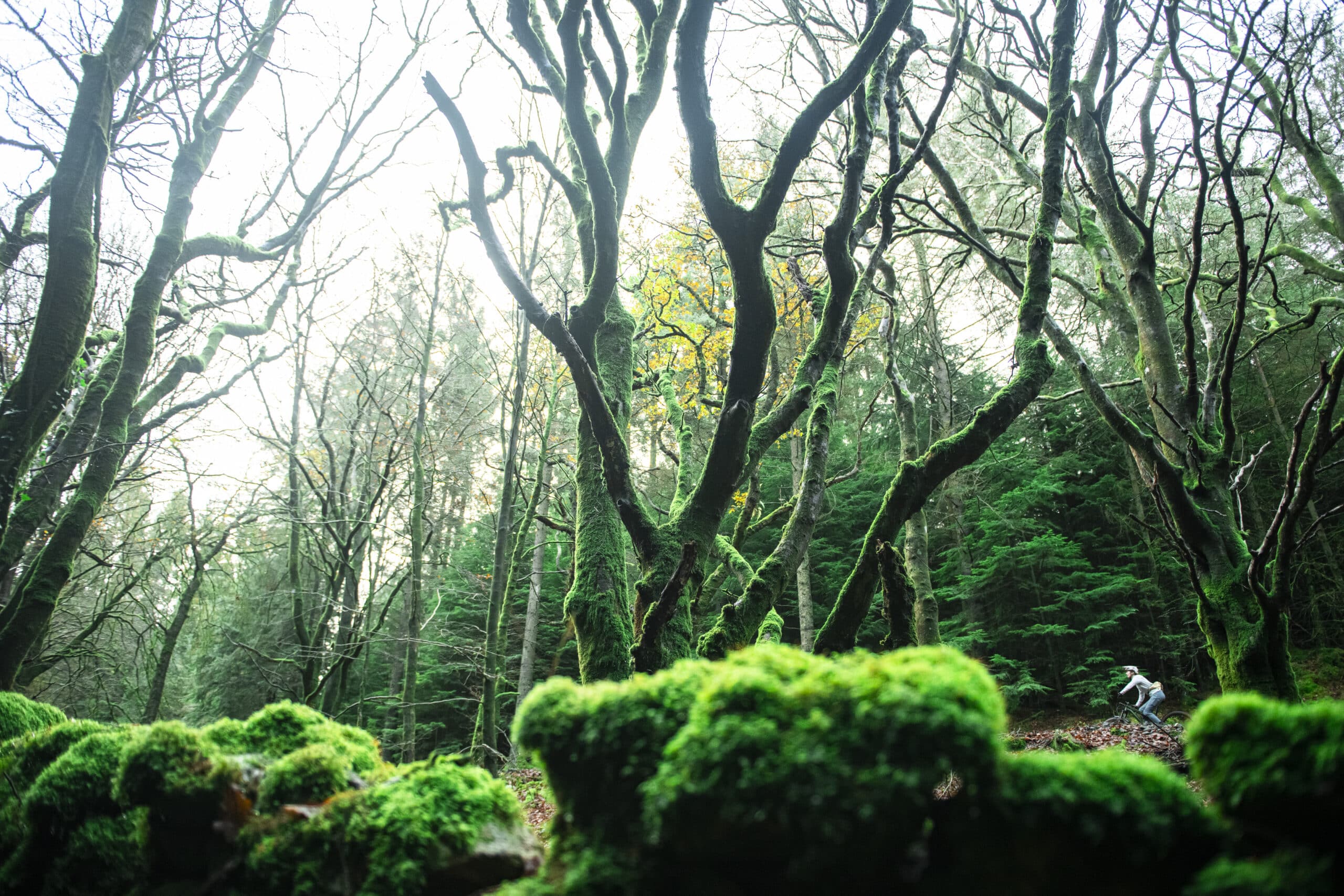
Almost as soon as we’re beyond the western hemlock though, we’re buoyed by the light and greenery beyond. A row of sizeable beech trees forms a bright avenue through the evergreens on their flanks. Here, mosses have crept higher up the trunks than the leviathan beech we saw earlier and the carpet of moss has consumed the dry stone wall below. This less natural substrata has become the new home for the moss. Hanging deadwood has also welcomed some fungi that have begun to grow beneath the bark. We’re almost ticking off the full list here…
Survival skills
A short spin up the fire road beyond and we’re at the top of Larg Hill. Here, plantation dominates. It’s clear that the hill has been planted and felled numerous times. The mass of tree stumps and brash beneath the second-generation pines give this away. On the far edge of the block, however, we see the unmistakable silhouette of Scots pines. Easily my favourite tree.
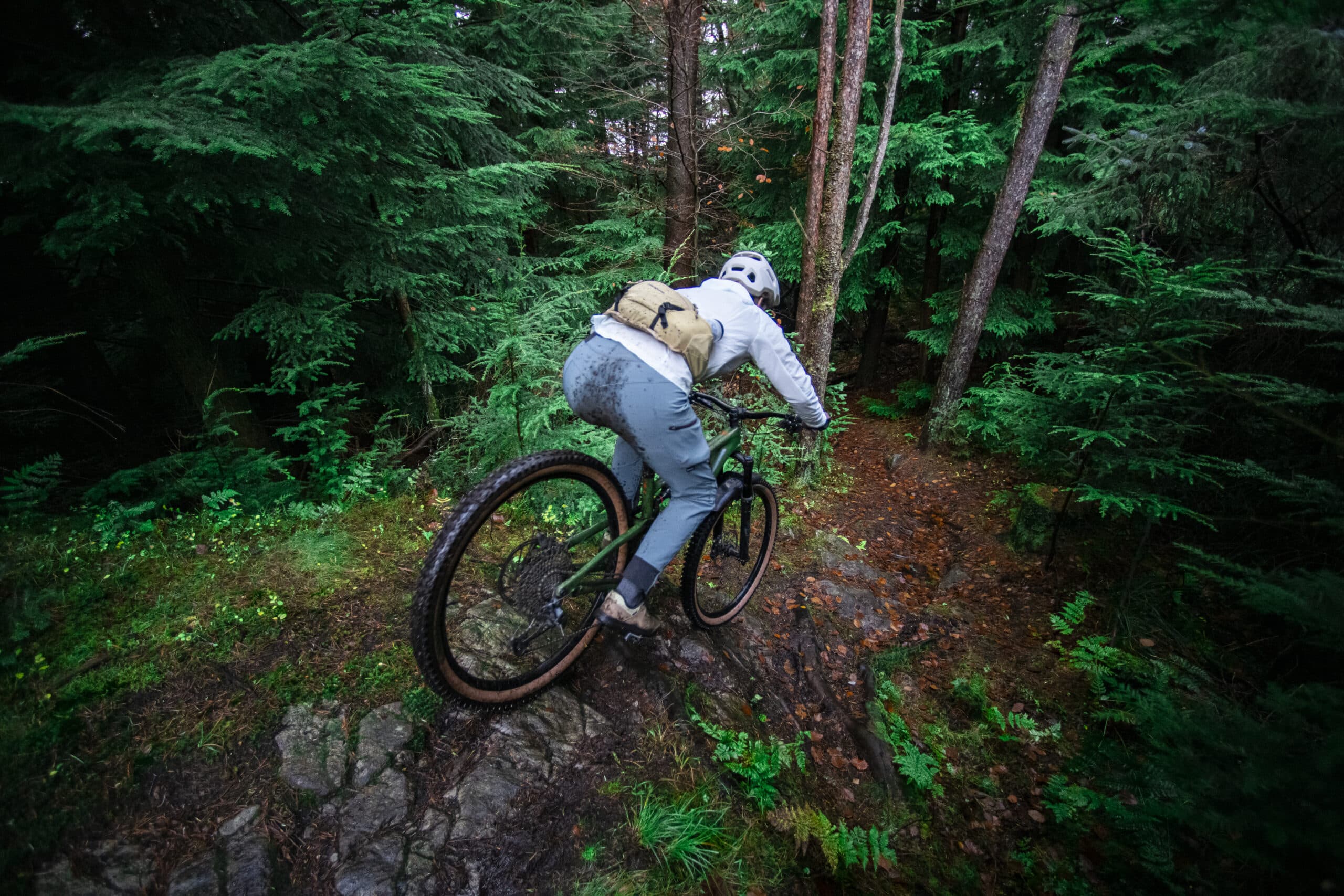
Our route across this block is on a trail made by locals. After the overnight rain, it’s a sopping delight and as we close in on the far side we discover an absolute technical treat, made even better by a complete lack of traction. Rarely have I seen such a disregard for grip from a trail. Root-strewn ruts give way to beech leaf-covered rock – neither offers the wheels anything to go at. Short but sweet, this trail has pushed our heart rates through the roof.
We exchange an ‘I’m glad we survived that’ look, followed by a duet of nervous laughter before trying to work out where to go next. On this dash down the hill from the plantation block above, it’s again the cliffs and rock that saved the older trees. Elsewhere, almost all of the ancient woodland has been replaced by several generations of tree crops.
By now, it’s getting close to lunch, so we opt to head back to the vans before taking in any more of Kirroughtree’s older native woodland. The map shows an extensive block on the far side of the valley that looks to have been thinned or felled, with another section on the return of the red route. We opt for the latter as any satellite images we could see show the tree cover there to be quite extensive.

With fuel down the hatch, we head out north and east along the red route. The climb off the fire road soon sees us leave the trees, and the view opens out. Almost simultaneously we pick out a stand of Scots pine with the odd small oak tree clinging onto its leaves for all its worth. Elsewhere it seems like the forest is regenerating; patches of clear fell have not been replanted, likely because of the mountain bike trails, and through the plantation we can see lots of windfall, much of which currently sees the black route closed for the foreseeable future.
Towards the end of a long, shallow climb is what we’re looking for in miniature. A lone oak tree stands between a large rocky escarpment and the plantation around it. The tree sports a heap of moss around its trunk and ferns sprout from this mossy jacket. At its feet, fungi has found its way through the moss below and one of the oak’s own acorns has found its way through to the daylight alongside the mushroom.
Forty-year recovery ride
As the light begins to drop, we start on our run back to the trailhead. The red route here, according to what we understand, runs through a block of ancient woodland. The amount of younger beech trees holding onto their bright yellow leaves stands out conspicuously in the shadow of some mighty Douglas firs, and there’s a decent amount of undergrowth here, so, while certainly not the dream, it’s not quite the worst either.
Ducking and weaving its way ever closer to its climax, the trail departs from the tree cover and we’re out in the same open expanse that the climb took us through, where broadleaf trees have been allowed the run of the hill and are slowly taking over. Slowly being the operative word. There’s little quick fix for restoring this type of lost woodland. Oak trees alone don’t begin producing acorns until they’re into their fourth decade, so usually you’ll need to start the process with pioneer species like silver birch or hazel, both beautiful trees that can and will grow anywhere, given half a chance.
Back at the vans, despite an excellent bike ride that had its spicy moments, it’s somewhat of a shame to see so much of the ancient woodland mapped by NatureScot simply no longer exists. The remaining bastions of these centuries-old forests are magnificent places to spend time, regardless of the mode of transport. More often than not they’ve been replaced by pine plantation, which is increasingly falling victim to winter storms that aren’t getting any less severe.
By contrast, none of the native trees we saw in the forest that day had been brought down in their droves by the high winds of the last few winters. The trees that make up our ancient woodland grow their roots deep, unlike the pines we see across much of the UK’s forests these days. Large ancient trees also sequester an amount of carbon that far exceeds that of the trees that more often than not replace them. We need these woodlands and forests. It’s that simple.
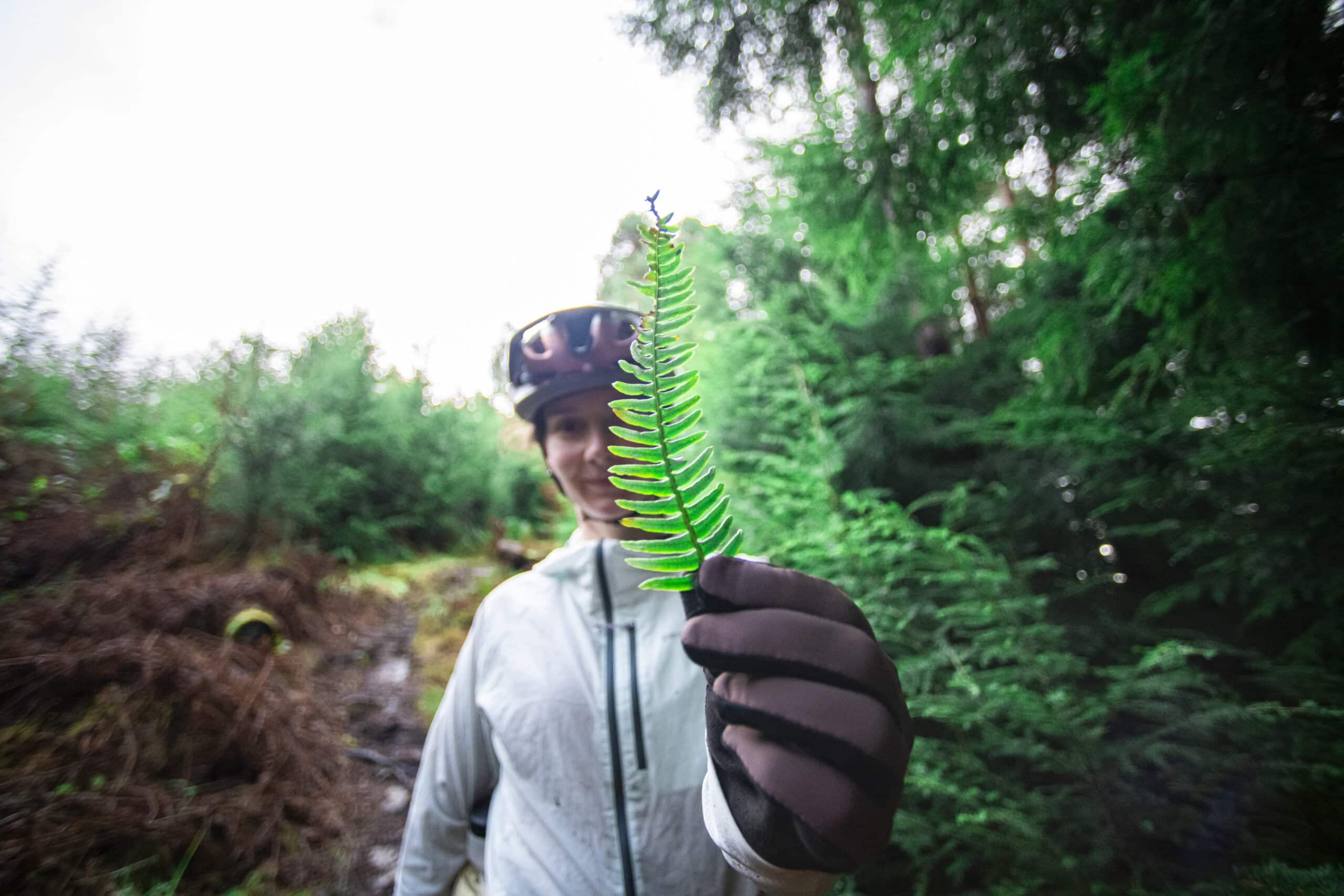
Manon’s top (amateur) tips to identify temperate rainforest
1. Location matters.
Britain’s major temperate rainforest zones are the wet western regions where the Atlantic Ocean-influenced climate means much precipitation and generally mild temperatures. Keep your eyes open when visiting the western flank of Scotland, Eryri (Snowdonia) and the Elenydd in Wales, and areas like the Lake District and West Country in England where rain and clouds often cloak topography.
2. Look for diversity.
In these damp woodlands, you can expect to see any combination of oak, ash, alder, Scots pine, willow or hazel, of all ages, hosting a green carpet of ‘epiphytes’. Epiphytes are plants that grow on other plants, and in this case, are mosses, liverworts, lichens and ferns, often seen growing on branches and tree trunks. Think magical, enchanted forest dripping in lichen and moss.
3. But not just moss.
Moss on its own is not an indicator of temperate rainforest. The significance of these ecosystems is the combination of species found, and finding liverworts growing among several different mosses is important in identifying temperate rainforest. Mosses and liverworts (bryophytes) have been around since before the dinosaurs, and over half of Europe’s bryophyte species can be found in the UK.
4. Rarely intact.
We’ve lost much of our temperate rainforest through shipbuilding and fuel, up to as recently as the 20th century. So you may find signs or fragments among plantation or invasive non-native species like rhododendrons creeping in, but when you are in an intact temperate rainforest it’s hard to miss.
5. Millennia-refined symbiosis.
These ecosystems are complex, varied, and time-sculpted. It’s the combination of open and closed tree canopy that creates both light and shade, dead standing trees and rotting stumps, and the rocks and boulders evolving into damp, mossy pillows which epiphyte communities make home over many years which make these forests so special. When intact, these forests act as giant sponges, retaining moisture from the forest floor to the tree tops.
Check out plantlife.org.uk and lostrainforestsofbritain.org for photos and more information.
It’s time to have your own Purposeful Adventure
From mountain tops to trail centres, Lakeland fells to plane wrecks, the places we ride a bike have plenty more going for them than the trail ahead. I hope this series has helped highlight this. One of Trash Free Trails’ major goals is to reconnect people with the places they often take for granted to give them a feeling of belonging and ownership of a space so that they feel like they need to protect it.
I have learned plenty of the history and diversity of many places I often didn’t give a second thought to, and these rides have shown me just how lucky we are to live on an island in the North Atlantic with such a storied history and unique environment. Some things I already knew have been reinforced, and I now see more of what I didn’t know everywhere. Humans have made their mark on the British Isles for millennia, and if you look closely, you can see the clues for what was, and what still is.
Next time you swing a leg over a bike, stop and think why the landscape around you is the way that it is. Whether it’s the plant life, the shape of the hills, or the narrow confines of a river, natural and human forces have exerted their influence on all of them.
Who are the Trash Free Trails A-Team?
First up: they are riders, runners and roamers just like you. Second up: they are passionate about making a positive impact. They volunteer their time and effort – and more often than not go the extra mile – to represent their trails and the communities who love and use them.
They have pledged to donate their time, passion and talent to protect and promote their trails for everyone to enjoy and we couldn’t be more thankful.
If you’ve got an idea for a trail clean, would like some guidance or just want to find other TRASHMOB members in your area, take a look at the A-TEAM map on the Trash Free Trails website and get in touch with your local representative. They’d love to have a natter.
